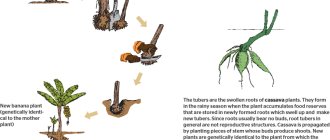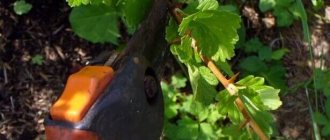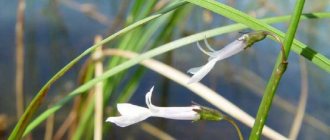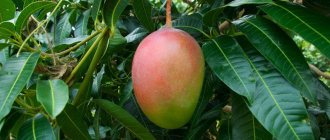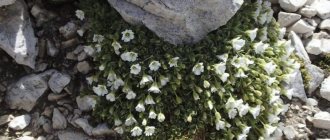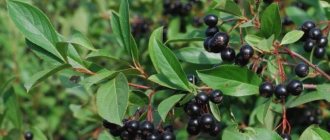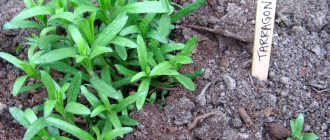Yasnotka (Lamium) is a genus of herbaceous plants, which is the type genus of the family of the same name (Lamiaceae), numbering up to 40 species, about half of them are found in the post-Soviet space. The natural habitat of lamellas covers Europe, non-tropical Asia and North Africa, but a number of species have naturalized throughout the world, turning into harmful weeds that infest agricultural land. At the same time, some wild species are widely used for decorative purposes, not to mention varieties that are excellent ground cover plants.
| Spotted lily Roseum |
The name Lamium in relation to this genus of plants was one of the first to be used by Pliny, who suggested that this word could come from the Greek laimos, meaning “mouth-throat”, or from lamos - large cavity, or from the name of the Libyan queen Lamia, whose history presents it as a monster capable of swallowing its own children. Likewise, the two-lipped clasp flower completely hides a bee or bumblebee that has dropped in for nectar.
Among the clasps there are annual, biennial and perennial species. Most of them have lodging and ascending stems that take root at the nodes. Due to strong branching, a continuous plant carpet is formed. The leaves are opposite, dark green, toothed, often pubescent, often with a silvery spot along the midrib. The foliage of many species resembles nettle in shape and pubescence, but the hairs, unlike it, do not sting. Flowers with a two-lipped corolla, often helmet-shaped, have a pubescent convex upper lip and a long tube, are collected in false whorls in the axils of the upper leaves, and are white, yellow, pink or purple in color. The fruit is a dry coenobium, consisting of four nut-shaped triangular lobes (erems).
Botanical description of jasmine
The process of developing clarity goes very quickly. It is for this feature that it is similar to a weed. The plant can reach a maximum of 25 centimeters in height. The root system is arranged in a fibrous type, so the shrub is able to quickly fill an area and decorate it with its branched crown. The foliage is shaped like a heart with a jagged edge, has a dark green color, and can sometimes be decorated with spots. In its center there are veins with a soft structure.
30-centimeter flower stalks develop in the internodes, gradually becoming overgrown with buds and foliage. The flowers consist of two-lipped corollas and can be painted in a variety of colors. Each of them has a stamen with a black anther of a purple hue. After the whorl has completely withered, fruits develop in the form of boxes with triangular nuts.
When they become mature, the seeds fall out on their own. This is how the claret reproduces. Its flowering period is long. It begins with the end of spring. And the fruits begin their development in the last days of June.
Determination formula
Genus:
Corolla irregular - corolla two-lipped - calyx on top without transverse outgrowth - four stamens - calyx not two-lipped - calyx with 5 almost equal teeth - calyx shorter than corolla - flowers in whorls - upper lip of corolla whole, helmet-shaped - only the middle lobe of the lower lip is well developed -
view :
corolla purple or pink - bracted leaves with petioles, not kidney-shaped - perennial with creeping rhizome, leaves on top with light spots, bent corolla tube, flowers 20-30 mm long.
Types of jasmine for growing in the garden
Yasnotka contains 25 species, but only some of them are grown for decorative purposes in the garden or in the area near the house.
- White lily (Lamium album) – popularly it is also called “dead nettle”. It has vertical, branched stems that can reach 15-45 centimeters in height. Their upper part is pubescent. The shape of the foliage is similar to an oval heart with a serrated edge. It is attached to the stems by short petioles. The buds have a two-lipped structure and have snow-white petals. They develop on the upper half of the stem in the leaf axils. The flowering period begins in June and continues until early autumn.
- Speckled/spotted lily (Lamium maculatum) – the length of erect stems is 30-70 centimeters. The edge of the oval foliage is serrated, and the leaf blades themselves are purple in color and have a silver stripe in the center. With the onset of the flowering period, the plant is decorated with dark purple or soft pink flowers, which attract many insects with their aroma. Breeders managed to develop several ornamental varieties from this species. Aureum has emerald yellow foliage with a narrow silver stripe and purple buds. Album is a miniature shrub with white petals. Beacon Silver is unique with silver leaves.
- Greenweed (Lamium galeobdolon) – thin, lodging shoots have pubescence that is soft to the touch. The foliage has a wrinkled structure and is often painted with a marbled pattern. The flowering period includes two stages from May to October. The buds are colored yellow. The Argentatum variety is unique with a wide silver edging on the leaf blades. Silver Carpet is a dwarf representative of Yasnotka zelenchukova. Its leaves have narrow teeth and a silvery pattern.
- Purple lily (Lamium purpureum) - a 25-centimeter species with dark green leaves and purple buds of a pink hue. This plant is capable of densely covering the ground with a living carpet. Its popular name is “red nettle”. It is frost-resistant, but a sudden change to cold temperatures can be disastrous.
- Lamium amplexicaule is practically not grown by gardeners due to its ability to displace other crops. But he is a good honey planter.
What is a plant like in nature?
The plant belongs to the family Lamiaceae, or Lamiaceae. Natural habitats are in Europe, Asia, and northern Africa. According to its “lifespan” it can be either an annual or a perennial. According to the “way of life” - wild grass and cultivated plants. Her favorite places in the wild are roadsides, forests (deciduous and coniferous), and river banks.
In Crimea, along the roads you can see fields with damselflies
The stem of the clasp is recumbent, branching, and the area on which the flowers are located is erect. The leaves are almost the same in shape as nettles, but without the burning hairs. In addition, their color is much more varied, especially among cultivated varieties. Nevertheless, the plant has a second name, emphasizing the external similarity of the plants - “dead nettle”.
Medicinal properties of jasmine
The jasmine plant is valued for its medicinal properties. It is rich in essential oils, ascorbic acid, alkaloids, tannins and flavonoids. Due to such a large amount of nutrients, infusions made from it help fight sore throat and inflammation. They are used as diuretics. Lotions from this herb are used to heal wounds, and hot baths are used for gynecological diseases.
But before using such folk remedies, you should consult your doctor. Although it has almost no contraindications, if the constituent elements are intolerant, an allergic reaction may occur.
Medicinal properties and contraindications
All types of this plant have healing properties. To a greater extent, they are possessed by the white damselfish. In folk medicine, the plant is famous for its hemostatic, expectorant, diuretic and other properties. It is used to treat gastric, pulmonary and gynecological diseases. The plant also helps to cope with toothache, depression, and is effective in healing wounds. Methods of use: decoctions, teas, compresses, baths and lotions.
Use in medicine of other types:
- Purple is used to treat skin diseases - urticaria, eczema, diathesis, furunculosis.
- The speckled appearance is effective in the treatment of liver and kidneys, gynecological diseases. Traditional medicine considers this plant one of the main ones in the treatment of insomnia and nervous disorders.
- The stem is used to treat bronchitis and asthma, jaundice and malaria.
Most plant species are not poisonous, but this natural medicine should not be abused. At risk are hypotensive patients and people suffering from atonic constipation.
How does the damselfish reproduce?
Clary grass reproduces easily. When a perennial shrub is transplanted to a new place, it is necessary to divide it into the required number of parts, and then plant them in prepared places. This method allows the plant to retain varietal characteristics. After the procedure, the plant takes root well if it has enough water. With the onset of the next growing season, the jasmine will already be able to bloom.
To carry out cuttings you must wait until August. Sand and peat are added to the dug holes in small quantities, and then the cuttings are deepened there. In order for them to be successfully established, it is extremely important to follow the watering regime.
September or October is suitable for propagation by layering. You just need to tilt them to the ground and sprinkle them with earth. By next spring, roots will have already developed, so the new shrub can be planted separately.
The seed method is recommended to be carried out in early spring or late autumn, simply scattering nuts on the surface of the ground. Although seedlings will appear quickly, flowering will occur only after a couple of years. Although the damselfish is capable of self-seeding, it is recommended to prevent this.
Reproduction
It is recommended to propagate jasmine in different ways - by seeds, dividing the bush, cuttings. The easiest way is to divide the bush. In this case, it is recommended to separate the shoots with roots and transplant them to a prepared area. Usually the procedure is performed in the spring. In summer, the rooted bush will bloom and produce new branches.
When carrying out cuttings, it is worth cutting off fresh shoots and moving them to moist soil. They must remain in this state for a long time. It is important that the soil does not dry out. Otherwise, there is a risk of problems with rooting of cuttings. To prevent moisture evaporation, mulch the soil. Peat and sawdust are used for this.
Seeds should be planted in spring. To do this, it is recommended to make holes and knead the soil to a powder state. It needs to be watered and seeds sprinkled in. It is enough to lightly press them down and sprinkle them with dry soil. The first shoots will appear only after 1.5 months.
The culture tolerates cold weather well. Therefore, it is recommended to plant seeds in mid-April or early May. It all depends on the climate of the region. It is not necessary to plant seedlings in a greenhouse.
After some time, the seeds will begin to sow on their own. This will lead to a large number of unplanned shoots. As a result, there will be no shortage of planting material.
Planting a claret
The soil should be moderately fertile, moist and have a loose structure. If it contains too many nutrients, then development will occur quickly, but without varietal characteristics. Before starting the procedure, it is recommended to prepare the area well by digging it up and clearing it of all weeds. In addition, you should also level the ground. After this, you can begin to evenly distribute the seed.
Clary grass can grow in one area for only 5 years. After this period is completed, it is recommended to update the bush and replant it.
Planting in open ground
In order for the claret to feel good in a summer cottage or in a park, you must try to create for it the conditions to which the plant is accustomed in its natural environment. They are quite modest: a shaded place where there is no sun, slightly moist soil, and not the most fertile, for example, loam or sandstone. The cultivated layer (of weak or moderate acidity) should not be large - 8–10 cm is quite enough.
If the area on the site is hilly, this is an ideal option: the plant loves ravines, tree-covered slopes, and the banks of reservoirs. It is especially comfortable on northern slopes, but southern and southwestern slopes are undesirable for it.
The plant will successfully develop under the canopy of trees (as often happens in nature), but will suffer from proximity to powerful herbaceous crops, especially if they are cereals.
If not properly cared for, the damselfish can turn into a weed.
Attention: too strong a shadow is still contraindicated for jasmine - its leaves become smaller and lose their decorative effect, their “silver” becomes dull.
Once the location has been chosen, planting begins. There are three breeding options:
- Dividing a bush is a very simple method that provides quick results. The plant quickly takes root and, if planted in the spring (the best time is from April to May), begins to bloom in the same summer.
- Cuttings are allowed during the entire growing season. Cut shoots without any pre-treatment are immediately planted in the soil, well fixed. The best cuttings are the apical part of the plant with buds and leaves and a bare stem 5 cm long.
- Sowing seeds ensures the appearance of seedlings in a month and a half. The soil must be moist so that the seeds can be lightly pressed into it. The seedling method is possible, but not rational.
Caring for claret
The plant needs moisture, but do not allow liquid to stagnate in the root system area. Otherwise it will begin to rot and die. If it rains often in the summer, then you don’t need to water it additionally. Drought has a negative effect on jasmine - its leaves begin to dry out and the stems become bare.
Before the onset of the growing season, the shrub should be fertilized with a mineral complex. Just before flowering, gardeners also use compost if they do not use fertilizing during planting.
When the inflorescences fade, it is better to remove them so that the appearance of the plant does not deteriorate. To obtain dense, juicy greens, you can mow the mats of this plant.
Most varieties of cherry are highly resistant to frost, so there is no point in covering them in the winter. But if, when purchasing seed according to the instructions, shelter was specified, then this must be followed.
Growing
Laminaria are quite demanding in terms of growing conditions. They love moist, loose, fertile soils. The ideal place for them is partial shade in the crown of trees or shrubs, under the walls of buildings, or near a fence. Provided good watering, they can grow in the sun, but in severe drought they wither. The least demanding of soil fertility and flexible to growing conditions is the spotted jasmine, which grows too quickly and widely on humus soils. Acceptable soil acidity is from slightly acidic to slightly alkaline (pH 6.1-7.8).
Caring for clarets is so simple that it would not be necessary to describe it. Compost is used as top dressing. After flowering, the flower stalks are cut off, which stimulates a new wave of flowering in late summer - early autumn and prevents unnecessary self-seeding. Flowering can last until October. Cutting or mowing also allows you to get a lot of young shoots, which support the decorative appearance of plants (this is especially important for varieties with interesting foliage), promote good overwintering and provide material for propagation. All named species overwinter well, without shelter.
Diseases and pests
If all the rules are followed during planting and cultivation, the plant does not get sick. But if it is over-watered, it can suffer so much that even fungicidal agents will not save it from death. It is important to notice this problem in time, even at the very appearance of symptoms. To help the claret recover, it is necessary to remove the affected specimens and treat the remaining shrubs with special means. This procedure can help prevent the spread of the disease.
Among the pests, spider mites most often infect jasmine. Symptoms of his work are silvery cobwebs. To combat these insects, acaricidal compounds should be used.
Although rare, the plant can also be damaged by scale insects, whiteflies and scale insects. Insecticidal preparations are used to destroy them.
Peculiarities
Yasnotka is a valuable garden perennial, which is valued for its uniform coverage of the area provided to it. Bright, plain or variegated foliage transforms any garden and gives the flowerbed a wonderful openwork background.
Lamily in the flowerbed
Lamily in the flowerbed
During flowering, the claret becomes even more decorative, and this period lasts several months and can be repeated closer to autumn. At the same time, the crop does not require special care or frequent feeding.
Other advantages are often cited:
- winter hardiness, ensuring longevity in the garden;
- the ability to quickly recover losses after damage by pests, drought or frostbite;
- the ability to select a variety based on growth and color;
- quick filling of clearings in the garden (between ornamental bushes, trees);
- design of large lawns without serious labor costs.
Perennial claret (types and varieties above) is used to camouflage outbuildings in the garden.
In addition, gardeners and designers note the excellent compatibility of clasp with a wide variety of flowers. In one flowerbed, the crop is combined with bulbous plants, ferns, hosta, heucheras, and gladioli. Low-growing varieties favorably set off garden primroses, crocuses, and snowdrops.
The unpretentiousness and speed of growth of jasmine allows you to mask temporary imperfections in the garden and hide utility structures. In undeveloped areas, the plant not only creates a picturesque carpet, but also eliminates weeds.
Lamia is confidently moving from the category of forest and field herbs to ornamental garden perennials. More and more selected species and varieties can be found on sale. At the same time, the persistent herb continues to be used as a medicinal plant for treating the genitourinary system, relieving inflammation, and generally strengthening the body.
Use in landscape design and the best flowerbed neighbors
Since the clearweed has the ability to quickly fill empty areas, it is good to plant it in areas with limited space. For example, it is placed between the building and the paths. In addition, it looks good as part of an alpine slide, as well as on a terrace made of stones. The plant is also planted in various containers and then placed in various flower beds as a focal point.
Spectacular combinations of this shrub are obtained with coniferous representatives of the flora such as fir, juniper, thuja and small fir. By planting a flowerbed of claret with daffodils, tulips or hyacinths, it is possible to create a wonderful partnership.
Preparing the soil and planting site
Laminaria is one of the few garden plants that tolerate partial shade well. It can be planted under loose tree crowns, near fences, and near the walls of buildings. Planting in a sunny location is also possible, but will require abundant and frequent watering.
In flower beds with diffused lighting, the decorative effect of natural types of clarets is best demonstrated. Selected varieties love the sun more.
Yasnotka is unpretentious to the composition of the soil. It is recommended to plant it on light, slightly acidic soils. The peculiarity of the crop is to grow excessively in fertilized areas. When there is an excess of nutrition, the jasmine wildly spreads in breadth. The leaves of variegated varieties lose their specific color and become simply green.
To prepare a flower bed, it is enough to dig up the soil, removing weeds. It is better to do this in the fall and leave the clods unbroken to freeze out the pests and their larvae.
